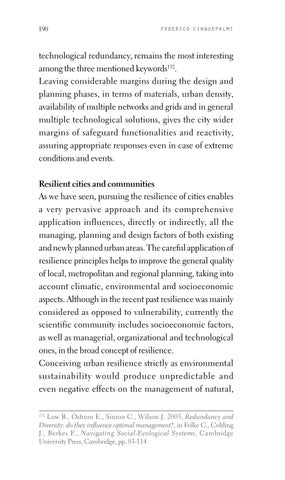190
federico cinquepalmi
technological redundancy, remains the most interesting among the three mentioned keywords132. Leaving considerable margins during the design and planning phases, in terms of materials, urban density, availability of multiple networks and grids and in general multiple technological solutions, gives the city wider margins of safeguard functionalities and reactivity, assuring appropriate responses even in case of extreme conditions and events. Resilient cities and communities As we have seen, pursuing the resilience of cities enables a very pervasive approach and its comprehensive application influences, directly or indirectly, all the managing, planning and design factors of both existing and newly planned urban areas. The careful application of resilience principles helps to improve the general quality of local, metropolitan and regional planning, taking into account climatic, environmental and socioeconomic aspects. Although in the recent past resilience was mainly considered as opposed to vulnerability, currently the scientific community includes socioeconomic factors, as well as managerial, organizational and technological ones, in the broad concept of resilience. Conceiving urban resilience strictly as environmental sustainability would produce unpredictable and even negative effects on the management of natural, Low B., Ostrom E., Simon C., Wilson J. 2003, Redundancy and Diversity: do they influence optimal management?, in Folke C., Colding J., Berkes F., Navigating Social-Ecological Systems, Cambridge University Press, Cambridge, pp. 83-114.
132
